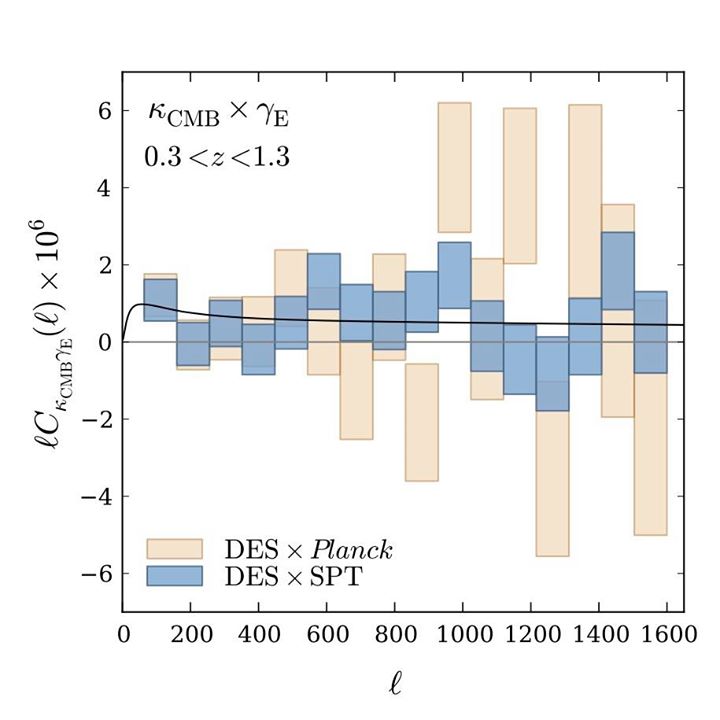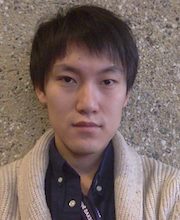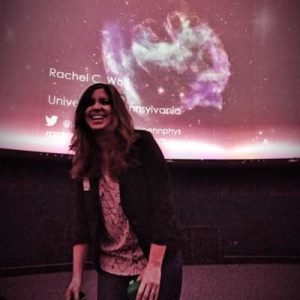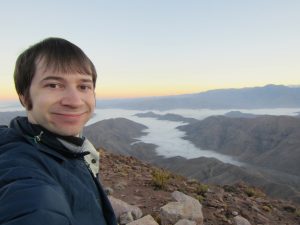Gravitational Lensing is a tool used by astronomers to study massive structures in the Universe, including galaxies and galaxy clusters, which are made of both visible and invisible (dark) matter. Any sign of deflected light is a signature of lensing. In this paper, we use maps showing locations of gravitational lensing from two very different sources of information: the shapes of galaxies in the Dark Energy Survey (DES) survey and the temperature maps of the cosmic microwave background (CMB) from the South Pole Telescope (SPT). Both tell us about the strength of lensing (the distortion of light by gravity) as a function of position on the sky. This lensing strength depends on the amount of mass between the light source and the observer and on the relative positions of the source, the observer and the “lens” mass.
We find that gravitational lensing of the light from DES galaxies (called “weak lensing” due to its very small signal) is positively correlated with lensing of the cosmic microwave background, measured by SPT. This is, in a sense, unsurprising – light from distant objects in the same patch of sky will both travel near the same foreground massive structures, and be lensed by them. However, the CMB comes from a much greater distance away and was emitted billions of years earlier than the light from galaxies in our sample. The CMB will show lensing effects from matter in the early Universe, as well as matter in the recent past. The light from the DES galaxies has been traveling for billions of years less time, so it only shows lensing effects from more recent history. Thus, the two lensing maps will not be exactly the same. How correlated these two lensing maps are give us information on how the distribution of matter in the Universe (large scale structure) has evolved over time, as well as the expansion history of the Universe including the effects of dark energy.
A positive detection of this correlation is a huge technical challenge, requiring very precise measurements of two very different sources of light. Our result is the third ever to be published and seeks to shed light on a the discrepancy between the first two measurements of how strongly these two lensing signals are correlated by using new, independent data sets on a different patch of sky.
We combine these maps, to measure their cross-correlation – that is, the extent to which the locations of lensing in each map are similar. We are able to calculate how correlated these lensing maps should be, assuming some details about the Universe and the distribution of galaxies from DES. We then fit our data with this prediction, finding something in very good agreement given the size of our errors (see figure below). This was in contrast to some of the previous results where the prediction did not match the measured correlation.

Here is a figure showing cross-correlations between the galaxy weak lensing and two different CMB lensing experiments SPT (blue) and the Planck space observatory (orange). The black line shows what we expect from theory and 0 shows the case if we have no signal.
This paper used the DES Science Verification data, a test set of measurements made before the official observations. Making this measurement now is a useful test run for our tools and procedures. It has helped us identify important points for improvement when DES will have much more data to analyze.
With DES data from year one of the full survey and beyond, as well as upgraded SPT data, we will be able to improve the accuracy of our measurement by a factor of 10 or more. This will not only produce the most accurate available measurement of this cross-correlation, but it will allow us to go beyond simple detection and use the result to learn a great deal more about cosmology – particularly the growth of large scale structure and expansion of the Universe over the past several billion years, as well as the extent to which galaxy shapes are aligned with their local massive structures.
About the Paper Authors

Donnacha Kirk is a post-doc at University College London. He has been a member of DES since 2008 and is interested in weak gravitational lensing, testing gravity and finding optimal ways to combine different probes of cosmology.

Yuuki Omori is a PhD student at McGill University. He works mainly with the SPT collaboration and is interested in CMB lensing and its relationship with other cosmological tracers.
About The DArchive Authors & Editors

Rachel C. Wolf is an astrophysics PhD candidate at the University of Pennsylvania. She is primarily interested in how to best use Type Ia supernovae to understand more about the evolution of our universe. Most of her work has focused on studying correlations between supernova brightness and host-galaxy properties and on creating new statistical techniques to compare observational data to cosmology theory. Rachel is also very passionate about science education and public outreach. She is involved in many projects in the Philadelphia community and serves as one of the co-coordinators of Education & Public Outreach for DES.

Chicago. He works on various projects studying the large scale structure
of the Universe using the millions of galaxies DES observes. These
projects include galaxy clustering, correlations of structure with the
cosmic microwave background, and using the structure of the Universe to infer redshifts of galaxies. Ross is also an active science communicator, volunteering at Chicago’s Adler Planetarium as well as writing and editing for The Darchives. He also loves observing for DES in Chile, where he has observed more than 30 nights.